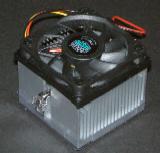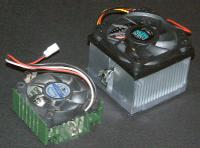
| Basics of a quiet pc - CPU Coolers |
 Keeping the CPU cool is vitally important, as an overheated CPU will result in system crashes and potentially permanent damage. A modern processor can
easily output over 60 watts of heat while running, and all of this heat needs to be removed with air cooling.
The fan on the CPU heatsink is probably the most important fan in the computer, as failure of this fan will usually result in the system failure.
Keeping the CPU cool is vitally important, as an overheated CPU will result in system crashes and potentially permanent damage. A modern processor can
easily output over 60 watts of heat while running, and all of this heat needs to be removed with air cooling.
The fan on the CPU heatsink is probably the most important fan in the computer, as failure of this fan will usually result in the system failure.
In order to reduce the noise from the cpu fan, there are two basics solutions
- Replace with a low noise heatsink and fan
- Replace with a larger heatsink and fan, and run the fan slower
 To run the fan slower there are a number of fan speed controllers on the market, that let you adjust the fan speed. You need to adjust the
fan speed so that it is quiet enough, but still runs fast enough to keep the cpu cool. You can usually monitor the cpu temperature from inside the BIOS setup,
and you should check that the cpu is not overheating. Also fans require more power when they are starting than while running normally, and you need to esure you
have not reduced the speed so much that the fan no longer starts.
To run the fan slower there are a number of fan speed controllers on the market, that let you adjust the fan speed. You need to adjust the
fan speed so that it is quiet enough, but still runs fast enough to keep the cpu cool. You can usually monitor the cpu temperature from inside the BIOS setup,
and you should check that the cpu is not overheating. Also fans require more power when they are starting than while running normally, and you need to esure you
have not reduced the speed so much that the fan no longer starts.
There is nowdays an alternative solution to reducing cpu fan noise, and that is to run a low power cpu, such as as VIA C3 processor, that does not require a heatsink fan. Low power processors only produce 1 to 10 watts of heat, and so can be passively cooled with just a large heatsink. They usually still need some airflow inside the case, but can cope without a fan on the cpu heatsink. They are however much less powerful than standard Intel and AMD processors, but provide plenty enough power for general day to day computing, such as word processing. This article was written on a PC with a VIA C3 processor.
Power Supplies << CPU Coolers >> Hard Drives
